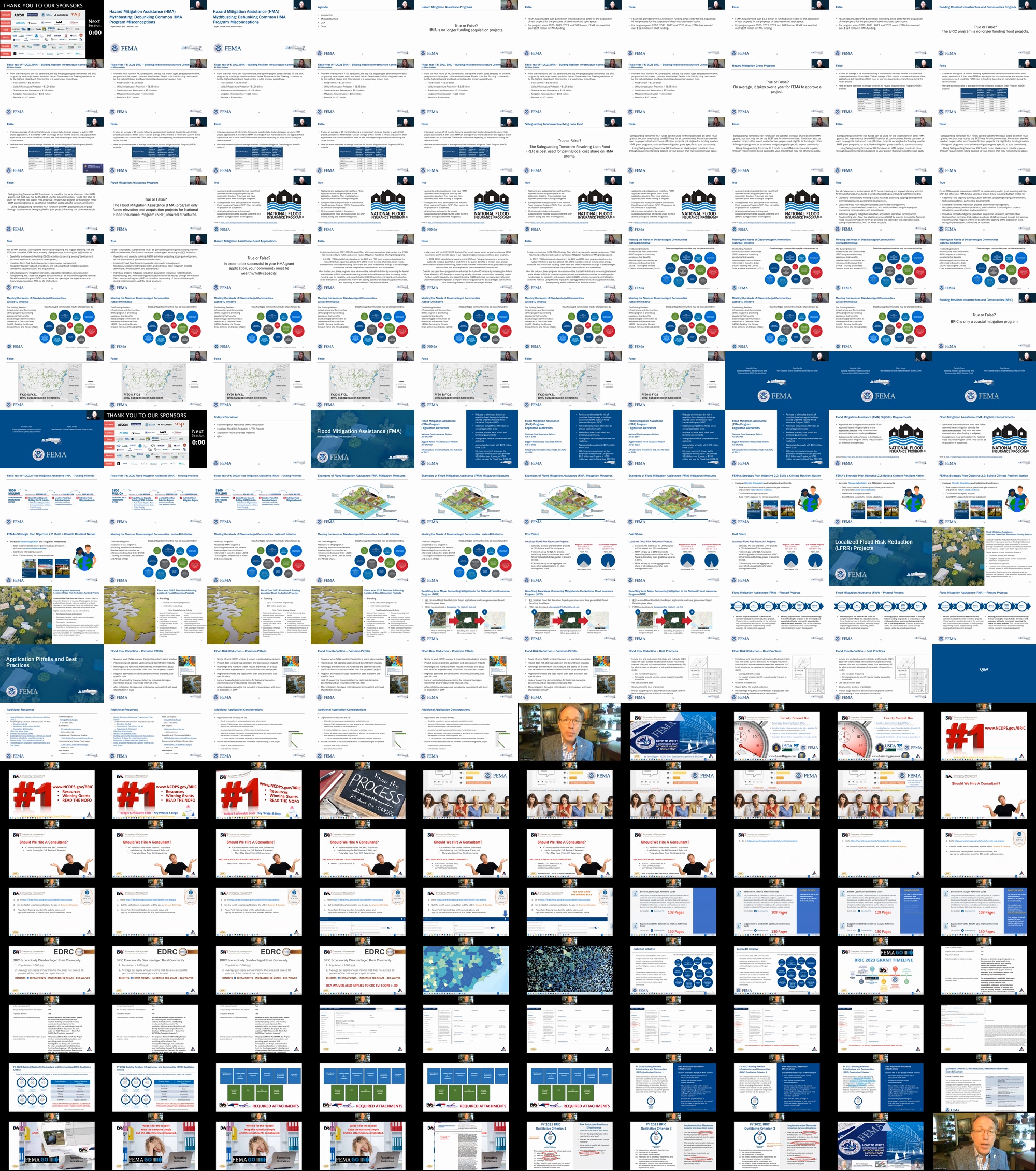Description
1) Hazard Mitigation Assistance (HMA) MythBusting: Debunking Common HMA Program Misconceptions
Ryan Janda, FIMA-FEMA ryan.janda@fema.dhs.gov
Co-presenters: Camille Crain, h-camille.crain@fema.dhs.gov
Abstract: For all too long, myths surrounding program eligibility and requirements have haunted FEMA and its stakeholders. Please join FEMA as they debunk some of the most pervasive myths that hamper stakeholder success. The HMA grant programs are designed to support state and local governments, tribes, and territories through helping communities build capability and capacity to improve resiliency to natural hazards. Despite the significant funding for community resilience currently available, many communities struggle with developing potential projects and submitting grant applications. In this session, FEMA will begin by providing a brief overview of the programs available for communities including the Hazard Mitigation Grant Program (HMPG), Flood Mitigation Assistance (FMA), Building Resilient Infrastructure and Communities (BRIC), Pre-Disaster Mitigation (PDM), and non-financial Direct Technical Assistance (DTA). Following this overview, FEMA will conduct an interactive “Myth Busters” presentation that will provide the audience with questions, offering them a chance to debunk misconceptions about HMA grant programs and the application process with the goal of better understanding HMA programs.
2) FMA Localized Flood Risk Reduction Projects & FY22 FMA Swift Current Initiative: Outcomes, Lessons Learned, and What’s Next
Brandon Sweezea, FIMA-FEMA, Brandon.Sweezea@fema.dhs.gov
Co-presenters: None
Abstract: Localized Flood Risk Reduction Projects (previously called Community Flood Mitigation Projects) is one of the priorities of the Flood Mitigation Assistance (FMA) program. These projects address localized flood risk for the purpose of protecting lives, property and infrastructure, and reducing National Flood Insurance Program (NFIP) flood claim payments. FEMA is allocating significantly more funds to the Localized Flood Risk Reduction Project priority due to the increase in funding made available to the FMA program through the Infrastructure Investment and Jobs Act (IIJA), more commonly referred to as the Bipartisan Infrastructure Law (BIL). For example, in FY22, FEMA allocated up to $340 million to Localized Flood Risk Reduction Projects, compared to $70 million in FY21. The goal of this session is to provide information and suggestions for Localized Flood Risk Reduction project design to encourage SLTTs to submit sub-applications to this priority in FY23. (The FY23 FMA application period will open in late September 2023.) This presentation will provide participants with:
- A clear understanding of the FMA Localized Flood Risk Reduction Project priority, including eligibility, cost share (including increased cost share established by the IIJA/BIL), priority scoring criteria (including CDC SVI), etc.
- Examples of projects that FEMA has funded under this priority
- Suggestions for project design
3) How To Write A Winning BRIC or FMA Grant Without Hiring A Consultant
Kaine Riggan, North Carolina Department of Public Safety, kaine.riggan@ncdps.gov
Co-presenters: None
Abstract: This presentation will show participants how to develop a winning BRIC and FMA grant application without having to hire a consultant. The session will brief the funding priorities for both of these FEMA grant programs ($3.1B awarded in the 2022 round) and show examples of the North Carolina projects funded in the national competition in 2020 and 2021. Participants will gain knowledge of the federal grant review process from the perspective of a federal grant panelist and discover the tools for developing a non-disaster infrastructure grant available through the North Carolina Department of Public Safety and FEMA.
Contributors
-
Ryan Janda
Ryan Janda is a Branch Chief in FEMA’s Hazard Mitigation Assistance Division. Currently, Ryan’s Branch manages the implementation of FEMA’s non-disaster mitigation grant programs which includes the Building Resilient Infrastructure and Communities, Flood Mitigation Assistance, and Pre-Disaster Mitigation grant programs. Ryan brings over 25 years of emergency management experience to his role as HMA’s Non-Disaster Implementation Branch Chief and has been managing the implementation of these programs since 2016. Prior to this position, he served as Deputy Branch Chief and Program Lead for the Hazard Mitigation Assistance Division. As Program Lead, Ryan was instrumental in implementing the merge of the flood mitigation grant programs into one combined Flood Mitigation Assistance program, as well as managing the Hazard Mitigation Grant Program and Pre-Disaster Mitigation program which have provided over $20 Billion to States, Tribes, Territories and communities since 1989. These programs provide much needed funding to make communities more resilient to natural hazards and their effects by implementing long-term risk reduction measures.
-
Brandon Sweezea
Brandon has been with FEMA for 10 years working both in the Region 10 field offices and at headquarters. Currently he is a Flood Mitigation Assistance (FMA) Section Chief for FEMA Headquarters in Washington, DC where he works within the NonDisaster Implementation Branch of Mitigation improving grant program delivery for projects that reduce risk on repetitively flooded building & communities nationwide. Previously, he was a project lead in FEMA Region 10 where he was in charge of managing disaster mitigation projects designed to improve community resiliency for State & Tribal communities in Washington and Oregon. While with FEMA he also deployed for Superstorm Sandy acting as the External Affairs Officer for the Manhattan Borough. Prior to coming to FEMA in 2011, Brandon was a Community Planner for Island County in Washington state where he reviewed land-use development permits, coordinated projects with internal and external partners, and developed Comprehensive Plan elements. His educational background includes a Bachelor’s in Political Science and a Master’s in Business Administration focusing on emerging technologies from the University of Washington. He holds a Project Management Professional (PMP), LEED Green Associate, Federal Grants Administration certifications, and is also an Eagle Scout.
-
Kaine Riggan
Kaine Riggan serves a federal grant panelist for the US Department of Labor, US Department of Agriculture, DHHS and other agencies, including FEMA. For the North Carolina Department of Public Safety, he has guided the state's cities and counties in winning more project awards in FEMA's Building Resilience In Communities (BRIC) grant competition than any other state for the first two years of the program.
